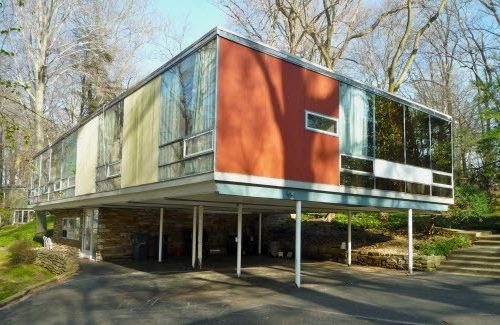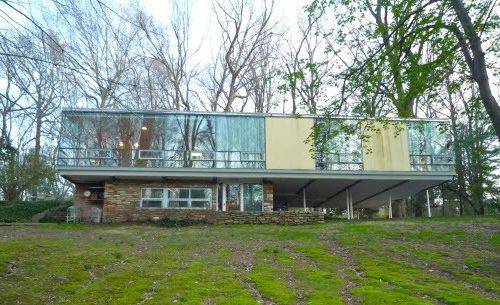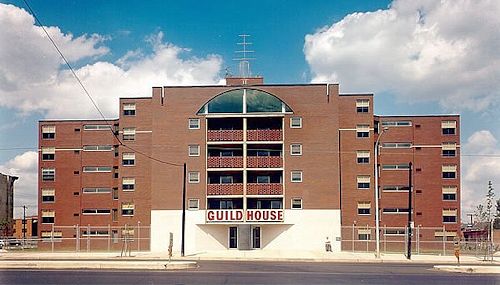2015.03.30 16:01
The Architect as Totalitarian
EKE, and I'll leave you off the hook as long as you remember that "Classical Architecture is not a universal sign of rightful order and beauty."
2015.04.06 11:05
What's your favorite piece of architecture?
Rather than just lists, it might be interesting to know whether an architect's favorite architectures are even experientially known by the architect. For example, of all the different buildings above, the only building that I have known inside and out is Whitemarsh Hall in its 1970s abandoned state. The other buildings I've experienced--Rialto Bridge, Habitat, Sydney Opera House, Loyola Law School, Vanna Venturi House, Gehry House--I've really only visited briefly and seen only from the outside. As to the rest (posted by others), I know those buildings only by pictures and sometimes also by drawings (plans, elevations, etc.). And my own list I know via interacting with the designs in 2D and 3D CAD.
I seriously wonder if it is realized how much appreciation of architecture is oft times more virtual than real. Like, my choices of favorite piece of architecture would be completely different if limited to within a 5 miles radius of where I live.
Frank Weise, Sheppard Residence, 1950-51


About 3 minutes away by car. Drive by it a few times a month, Never been inside, but there are interior shots online. Wish I knew it was on sale a few years ago; would have seriously considered buying it. Koolhaas wo bist du?
| |
2015.04.08 19:41
Low-income housing in Los Angeles: A look at the past, present and future

Do most architects today know that Guild House is "low-income housing"? It will be 50 years old sometime within the next 365 days.
2015.04.27 11:09
what is 'beauty' in Architecture?
"Cultures, he argued, need the challenge of new forms if they are not to settle into complacency or, worse, terror.
His target here is what he calls 'realism'. Realism, he claims, reaffirms the illusion that we are able to seize hold of reality, truth, the way things "really" are.
Realism, Lyotard argues, protects us from doubt. It offers us a picture of the world that we seem to know, and in the process confirms our own status as knowing subjects by reaffirming that picture as true. Things are, humans are, and, above all, we are just as we have always supposed.
Postmodernity, in Lyotard's account, specifies a different literary and artistic mode rather than a particular period. Duchamp's challenge to realism is intelligible as postmodern. 'You want realism?' Richard Mutt's urinal seemed to ask. 'I'll give you reality itself, a readymade urinal, exactly the kind you see every day'. Er, that is, the kind men see every day. Well, Western men, anyway. Reality itself, when you come to think of it, is also culturally relative."
--Catherine Belsey
2015.04.30 12:22
‘Architecture is now a tool of capital, complicit in a purpose antithetical to its social mission’
Public funded housing throughout the 20th century provided a multitude of big commissions for architects, often at times when big architecture commissions were difficult to come by.
It's not a stretch then to see architects advocating public housing as a means for there being more architectural commissions available, as well as for the greater good.
2015.05.27 11:40
New photos of E. Fay Jones' Thorncrown Chapel unveiled to mark 35th anniversary
The notion of "whether imitating Frank Lloyd Wright's style in a quite direct way, especially now in the 21st century, qualifies as a viable and productive pursuit in and for architectural design" was not the issue. You said "imitating Frank Lloyd Wright is invariably not productive at all," and I asked for evidence of that supposition. Your reply offered no real evidence and a loose justification of your supposition, and that is what I have issue with.
I can more readily agree with the notion that FLW's architecture has so far 'proven' to be an uneasy paradigm for other architects to follow. Yet such a supposition would necessitate a study of FLW's designs more so than the designs of the 'imitators' to see where the difficulties lie. Your language--imitating Frank Lloyd Wright is invariably not productive at all--comes off more as an ongoing deterrent for designers to even try as opposed to an accurate assessment of the situation.
Regarding Thorncrown Chapel, it looks to me that whole lower zone, where people are in direct contact with the building, is all imitation FLW, and the whole upper zone doesn't necessarily evoke FLW at all.
| |
2015.05.27 19:15
New photos of E. Fay Jones' Thorncrown Chapel unveiled to mark 35th anniversary
Perhaps, because Wright set up his own pedagogy, his 'way' was not taught more throughout architectural academia.
2015.06.01 21:22
Why do Americans love this style of architecture so much?
Look at the work of Charles Moore from the late 1970s through the 1980s; that's the real precedent for this "style". It's all really a side-effect of Charles Moore's post-modern style. It was/is extremely easy for commercial architects to copy, and it fell in perfectly with then-newly popular building products like Dry-Vit/EIFS. The late 1970s-1980s designs of Michael Graves were also a strong influence. Perhaps call it the Post-Modern Side-Effect Style.
Venturi usually gets blamed for this stuff, but really, look at the work of Charles Moore because that's where you'll see near identical detailing.
2015.06.01 21:34
Why do Americans love this style of architecture so much?
In many ways, you can describe Charles Moore's post-modern style as neo-vernacular craft.
2015.06.01 21:55
Why do Americans love this style of architecture so much?
neo-vernacular craft in style
I live in a developer built house from 1975. It's all an easily repeated kit of parts with very little craft involved at all. Craft in construction since the mid-1970s is more a rare occurrence than the norm.
2015.06.08 10:50
New photos of E. Fay Jones' Thorncrown Chapel unveiled to mark 35th anniversary
I wish I could find that Scott Brown quote from a year or two ago where she says Venturi is no longer interested in architecture. Perhaps it was only me, but the way it was phrased conjured up scenes from Whatever Happened to Baby Jane?.
Coincidentally, James Stirling died 25 June 1992.
2015.06.08 11:58
New photos of E. Fay Jones' Thorncrown Chapel unveiled to mark 35th anniversary
I found the quotation:
Q: As a result of that story, a group of women graduate students at Harvard launched a petition asking that the Pritzker committee recognize your work. What is Mr. Venturi’s opinion of all this? Didn’t he recently sign the petition?
A: He signed the petition, yes. Read what he wrote. Bob believes—how does he put it: “Excuse nothing. Explain nothing.” So he wanted to put something that represents his feelings and didn’t excuse and explain. I think he did something very cool and very nice. It’s also hard for him. It’s hard on many levels. By the way, they said he is unwell. He isn’t unwell, he is just old. He doesn’t really want to be involved in architecture very much—or in this quarrel.
|